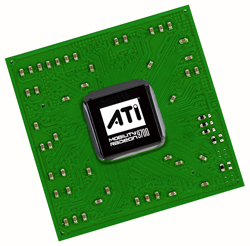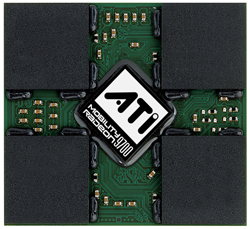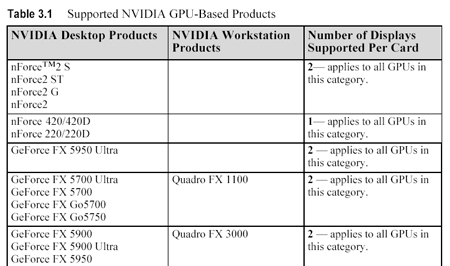
Original Link: https://www.anandtech.com/show/1231
ATI's Mobility Radeon 9700 - What's in a name?
by Andrew Ku on February 3, 2004 12:50 AM EST- Posted in
- Laptops
The word is out - ATI has released their newest mobile GPU, code named M11, which is the successor to the Mobility Radeon 9600 family. As we mentioned in our mobile GPU Q1/2004 update, ATI and NVIDIA did not announce their next gen mobile GPUs at the same time. Instead, NVIDIA announced NV36M, dubbed GeForce FX Go5700, back at Comdex. And today, ATI's M11 newly christened Mobility Radeon 9700 officially hits the market. (It isn't based on the R300 core, but we will explain all of that later.)
While gaming/rendering on notebooks has never been up to par with desktop stuff (barring overly large-sized notebooks), the gap between the two has been slowly narrowing, and the sales for desktop replacements have been steadily on the upswing. The high-end mobile graphic solution for notebooks is now basically comparable to the mainstream desktop graphic stuff (of course, the 9600 name helps to get ATI's point across).
After enjoying the success of the M10 GPU, ATI doesn't want to slow down in the mobile segment at all. But they are still very cautious of the moves that they make in tandem to their competitor. While the Mobility Radeon 9600 is shaping up to be a very resilient mobile GPU, ATI still has a lot of work ahead, if they want to maintain the dominant position in the mobile GPU market.
M11 and its successor (we will get to that some other day) are supposed to be just that: the insurance ATI needs to solidify their mobile GPU market position. By all present indicators, the Mobility Radeon 9600 family looks like its going to be around for a while. ATI is positioning the M11 GPU to be the higher end derivative of its mobile graphics family, while the Mobility Radeon 9600 trio will remain in place as mainstream solutions. With that having been said, let's get to the good stuff.
ATI Mobility Radeon 9700 - All the details
As you no doubt expect, the Mobility Radeon 9700 is based on the R360 architecture; its desktop brother being the Radeon 9600 XT. So, like we mentioned in our mobile GPU Q1/2004 update, ATI wasn't going to use the "Mobility Radeon 9600 XT" naming derivative for the M11, a decision that was settled some time ago. Based on the R360 core, M11 is manufactured on a low-k dielectric 0.13-micron process, which makes it the first mobile GPU of this nature.The benefits of a low-k dielectric are mainly related to shielding from crosstalk in high transistor density chips. The benefit of a low-k process is mainly the ability to scale up clock speeds while maintaining low power consumption and low thermal emissions. The latter reasons provide a big selling point to system manufacturers. Assuming that the M11 has an increase in performance over M10, it proves to be a very tempting solution, since it has no noticeable increase in the operating voltage and power consumption spec from the M10.
There are no specific "official" clocks for the Mobility Radeon 9700, for the reasons we explained in our mobile GPU Q1/2004 update. However, ATI tells us that their customers are going to implement the Mobility Radeon 9700 with core clocks in the range of 390MHz to 450MHz, while the memory clocks will run in the range of 200MHz to 260MHz. One of the big design wins for ATI runs slightly above the memory range, which ATI is more or less mandating to their customers. This suggests that the aim for ATI in core clock will remain 450MHz, while the memory clock is something like 275MHz, since ATI and NVIDIA traditionally announce "official" clocks that are in 25MHz derivatives.
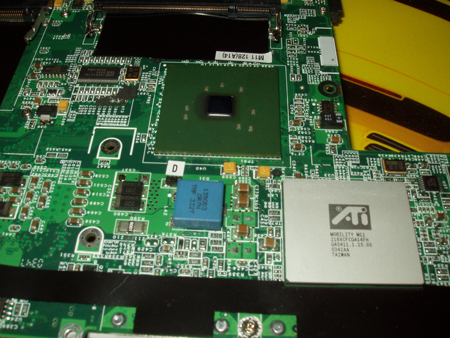
(Click to enlarge.)
Our experience with notebooks has been that the M10 GPU can run effectively with passive or minimal active cooling designs. Meanwhile, the M11 GPU needs a more extensive passive cooling design (i.e. a larger heatpipe) or a small heatsink fan. This seems to be the reason why ATI is utilizing an integrated heat spreader on some of its chips.
As far as naming is concerned, you are probably scratching your head on ATI's choice of Mobility Radeon 9700. After all, the Radeon 9700 Pro (R300) has eight rendering pipelines, while the Mobility Radeon 9700 has four. The 9700 designation for the M11, though, is mainly to due to the Mobility Radeon 9600 and desktop "XT" designations. ATI has, thus far, reserved the use of the post-fix "XT" for desktop cards that support OverDrive, and the fact that the majority of laptops weren't going to implement OverDrive wasn't going to play to ATI's benefit. Prospective notebooks would just be puzzled in the end due to the lack of the feature, which couldn't be enabled by the end user because the system vendor would choose to disable the hardware component that supports the OverDrive capability.
Making things a bit more complicated, the Mobility Radeon 9600 name has been stretched much further than originally planned. The Mobility Radeon 9600 Pro was supposed to feature GDDR2-M and OverDrive, but due to the cancellation of the memory by Elphida, the Pro version was just a slightly higher clocked version of the non-Pro. The addition of the Turbo Pro threw a monkey wrench into the mix by creating a three-tier Mobility Radeon 9600 family.
Dubbing the M11 as Mobility Radeon 9600 XT would create a nice middle class suburbanite family of four. Because M11 is called "M11" and not "M10.5", ATI wants to emphasize that it is a generation jump, and using the 9600 obviously wouldn't create that impression (aside from the obvious conclusion that you would draw about its performance). Naming it "Mobility Radeon 9800" would no doubt be a stretch, so Mobility Radeon 9700 came as the most obvious solution. This is more of a lack of options due to unforeseen repercussions because of the Mobility Radeon 9600 three-tier naming mess. The question is then, "does the M11 live up to the name ATI has given it?" Of course, we will get to that in a bit.
ATI Mobility Radeon 9700 - Where can I get one?
So, with all the hubbub, you're probably wondering where you can get a notebook with ATI's Mobility Radeon 9700. There are several notebook partners with whom ATI has launched today. We should clarify that, just because ATI or NVIDIA "launches" with a system vendor that doesn't mean a design win. You should expect a design win from the launching partners, but most often, system manufacturers hold off announcing the actual notebook model until they are ready to ship, which means ATI and NVIDIA need to hold off claiming that design win.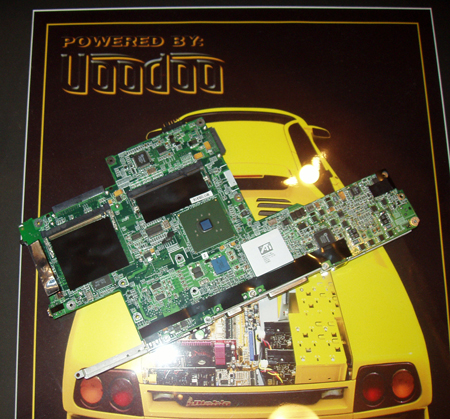
(Click to enlarge.)
Today, ATI is launching with Acer, Gericom, Alienware, Voodoo PC, Medion, RockDirect, Packard-Bell, Fujitsu-Siemens, Samsung, LG, Targa, Wistron, Clevo (the guys who make the notebooks that were pre-announcing the Mobility Radeon 9700 in the US), ECS, FIC, Quanta, Compal, Uniwill, and Asus. The first shipping notebooks will not be in the US market; instead, they will be in Europe. ATI and a few launching partners are announcing design wins, since the European market will experience the availability of Mobility Radeon 9700 based notebooks as of today. These notebooks will start to ship immediately, but we should make this clear: do not expect to get one of these unless you are actually located in Europe.
Interestingly enough, it seems that there is somewhat of a shortage of M11 chips for a few of the OEMs and ODMs. This has led to the inability for many of them to ship out notebooks on their original timeline or in the large quantities originally intended. So basically, several of them have delayed their product announcement and shipment by a little over two weeks, or have cut down on the initial quantity. ATI has already responded to the large demand for its chips, so this is a very temporary issue that will only affect some of the launch partners for a few weeks.
There is one BIG notebook manufacturer that has not announced along side with ATI, but will do so and ship in approximately a week. We can't say more than that for the moment, but it is definitely a design win that ATI will be touting. We will cover more on it when the time comes.
NVIDIA GeForce FX Go5700 - And so the tumbleweed rolled...
While NVIDIA announced their product back in November, we have yet to find a shipping notebook with that design. According to our previous talks, we should have expected to see at least one shipping notebook by the end of January. For whatever reason, the shipping timeline for that specific launch partner of NVIDIA's GeForce FX Go5700 has been delayed a bit, as no specific design wins have been announced. We still expect to see something from Alienware, Compal, FIC, Toshiba's Digital Products Division, Quanta, or Uniwill sometime within a few weeks. Alienware already confirmed that they will be using the Go5700 in their upgradeable graphics module, which depending on how you look at it, it can be considered a design win. However, Alienware is not taking orders or shipping it quite yet.The only thing that is new to the mobile GPU scene (other than ATI's Mobility Radeon 9700) is NV36M Ultra. We don't have many details on this, but it is logical to assume that the official clock speeds of the NV36M Ultra should be higher than NV36M. Because the higher clocks, the NV36M Ultra should be like the GeForce FX 5700 Ultra in the sense of requiring an additional power bridge or operating at the lower disconnected power clocks.
The naming of the NV36M may likely be the Go5700 Ultra, similar to the tiering of the desktop family. However, it is interesting that in the release notes of the Forceware 52.16 drivers, there is something called, "GeForce FX Go5750". We aren't quite sure if it is a fluke, but NVIDIA has already abandoned the wire bond package for post-NV35 architectures, which was the basis to name the Go5650.
With this line up, NV36M (Go5700) would then be pitted against the M10 family (Mobility Radeon 9600) while the NV36M Ultra faces off against M11 (Mobility Radeon 9700). Because notebook manufacturers are concerned traditionally with power consumption and thermal emissions over performance, NVIDIA is already at a disadvantage, since the NV36M and NV36M Ultra GPUs are based on NV36 architecture, which was designed to implement an auxiliary power source. This would seem to suggest that NVIDIA will likely compete more aggressively with ATI for desktop replacement design wins, while ATI has an advantage in the traditional and thin and light notebook form factors. The question for desktop replacement notebook manufacturers would then be the benefits of NVIDIA in the context of performance as a trade off for power consumption. The verdict is out and perhaps NVIDIA will have surprises for us. We will touch more on this later.
Video Memory Bus - Hasta la vista, buses...
One of the most unaddressed topics for mobility products has been memory bus termination. Buses are routed on high speed PCB traces that work in the similar sense to transmission lines. If you leave the "lines" open, electrical signals could reflect back and distortion with the communication of the controller and controlled devices. Signal distortion can produce or contribute to things like erroneous bits in data, false memory addresses, etc. The way to avoid this is to use termination to close each end of the buses with resistor circuits.As far as we know, there are no mobile GPU designs that use full termination (also called parallel termination). Serial and no termination have been the traditional methods used for virtually all notebook designs. Note that ATI's own brand of desktop cards implement full termination. This is in the sense of the GPU memory bus not the AGP bus, which are independent of one another.
This is what Rahul Sood, President of Voodoo PC, had to say on the topic:
There are traditionally three memory termination options depending on trade-offs amongst performance, power consumption and PCB space. They are: no termination (lowest speed, least PCB space requirement), serial, and full termination (highest speed, largest PCB space requirement).The implementation of full termination comes with several trade offs, like increased power consumption/thermal emissions and an increase in necessary PCB real estate, while the system generally benefits from performance and the ability to crack up the clocks. We have been told that there may be a fully terminated Mobility Radeon 9700 design popping up sometime soon, but the details are still sketchy at this point.
For short traces (< 2 inches), the so called "half parallel" termination, essentially full termination without the series resistor, is a good compromise between performance and space requirement.
The Test
This time around, we weren't able to arrange an ATI and NVIDIA head-to-head because of the timeline of the two products. Secondly, we would be highly sensitive to pitting the NV36M/NV36M Ultra against M11, unless we found a notebook that implements both in a modular graphics format.Considering many of the games that we use are at least partially CPU bound, there would be no other way to render a judgment without leaving a shred of questionability. The other option for this would be to use a reference mobile card in a desktop system. This is basically a mobile GPU slapped on an AGP card for QA testing purposes, which would be duplicating the scenario for testing desktop cards where the GPU itself can be isolated for testing. This is the only way that we could compare the Mobility Radeon 9700 against the Mobility Radeon 9600 Pro to show if there is a performance increase.
As we have noted in the past, the problem with using reference cards have been two-fold: first, we have almost no idea what to run the clocks of the reference card at; and the second, the reference cards are, in many cases, pre-fabricated prototypes. Our benchmarks setup, therefore, is designed to be reflective of one of the upcoming Mobility Radeon 9700 based desktop replacement notebooks by using a desktop platform with reference cards (M10 and M11). We ran the Mobility Radeon 9700 at clock speeds that are identical to the unannounced design win, which will be introduced into the market within a week and a half.
| Windows XP Professional Desktop Test System | |||||||
| CPU(s) | 2.8GHz Pentium 4 (Prescott) | ||||||
| Motherboard(s) | Asus P4P800-VM | ||||||
| Memory | 1GB DDR400 | ||||||
| Hard Drive | 80GB Seagate 8MB 7200RPM (SATA) | ||||||
| Video Card(s) | ATI Mobility Radeon 9600 Pro 128MB 128-bit DDR ATI Mobility Radeon 9700 128MB 128-bit DDR |
||||||
| Ethernet | Onboard Ethernet Adapter | ||||||
| Operating System | Windows XP Professional SP1 | ||||||
| Video Drivers | ATI Catalyst 4.1 build | ||||||
For those curious readers, we ran several benchmarks on this unannounced notebook to verify its performance in comparison with our desktop configuration and Mobility Radeon 9700 reference card. There was no notable margin of difference between the two. Due to the NDAs, we can't say the exact clocks that we ran the Mobility Radeon 9700, but they are of high-end spectrum at which ATI is mandating the GPU to be run. As for the M10, we ran it at the Mobility Radeon 9600 Pro requirements, which made it slightly slower in the memory clock department compared to our Mobility Radeon 9600 and GeForce FX Go5650 head to head.
Aquamark 3
Starting off with Aquamark 3, the Mobility Radeon 9700 takes a 28% increase over its predecessor. Scaling up to 1280x1024 only increases that gap marginally to 29%. These are the scores that ATI is, no doubt, helping to justify the naming in order to emphasis the "generation jump."
Call of Duty
This is a new title that we added to the mix since it is one of the most popular titles at the moment. This is another game of the first-person shooter genre, where you work on missions with your army's "company" to accomplish specified goals. Call of Duty is based on the Quake 3 engine, but it is a heavily modified version so that it can incorporate DX9 features. We ran a replay of a LAN game played among several players via the console, which is not available in the demo version of the game. Since Call of Duty caps the frames per second, we had to max out the cap value at "999" so that the benchmark could replay at its highest possible frame rate.We should note that this game doesn't really implement ps2.0 shaders. Instead, it is more like a DX8.1 title running in a DX9 API. Keep in mind that it is also an OpenGL title.
This is one of two titles in our benchmark suite that provided the Mobility Radeon 9700 with a sub 10% margin. This doesn't seem to be the normal scenario, except for a few titles in lower resolutions. When we get to the 1280x1024 resolution, the margin jumps 17% (from 9% to 26%). This scenario is much more reminiscent of our Aquamark 3 scores.
It's very important to note that the Mobility Radeon 9700 takes a performance degrade (when jumping to a higher resolution) much better than the Mobility Radeon 9600 Pro. While the Mobility Radeon 9700 only suffers a roughly 4% degrade, the Mobility Radeon 9600 Pro takes a 16% drop from 1024x768 to 1280x1024. This is more of the clock for clock performance that ATI is clearly benefiting from the low-k process of the R360 graphics core.
As popular as Call of Duty is, it isn't that graphically intensive compared to some of the other titles at our disposal. Both of ATI's mobile GPUs can comfortably run well above the 50fps market, and it is our experience that AA and AF can be scaled up while achieving smooth game play.
Halo
Since Half Life 2 isn't out, Halo still remains to be one of the best cases to test DX9 features.Considering that we are testing out mobile GPUs, there isn't a significant need to turn up AA and AF for this title. The Mobility Radeon 9600 Pro still runs slightly under what we would call smooth game play, since it achieves 23fps in 1024x768 and 15.2fps in 1280x1024. ATI's new mobile GPU starts to make things much smoother as it actually does 30.6fps in 1024x768 and a less desirable 20fps in 1280x1024. Scaling-wise, the Mobility Radeon 9700 initially takes a 30% increase over the Mobility Radeon 9600 Pro and adds to that gap minimally by 2% in 1280x1024.
Jedi Academy
Both GPUs can perform comfortably here in non- AA and AF modes, even unto the 1600x1200 resolution. Our game playback here is not the same used for our desktop benchmark scores. Instead, we are using a playback of a LAN game where gameplay is more intensive as opposed to single player mode.
The only sub 30fps score here comes from the Mobility Radeon 9600 Pro, which drops to 27.1 in 1280x1024. This is mainly due to our 8xAF setting. Between the two resolutions, the margin between the Mobility Radeon 9600 Pro and Mobility Radeon 9700 remains at 24%.
Knights of the Old Republic
This is another title that we have thrown into the mix, and is a RPG game that implements some very impressive DX9 features, particularly in some of the landscape scenes. This is one that we had to benchmark by fraps, since there is no built-in benchmark console. Compounding the difficulty was the fact that some of the cut scenes are rendered within the game engine and some aren't.We did manage to find a cut scene that was done within the game engine, and our benchmark segment consisted of that plus our guy running up and battling a gang with a companion. There are small variations with this testing, such as bad guy one firing before you hit him with your blade. But once you fight, the computer takes control of the actual fight moves. So no doubt, it was difficult to find a scene to benchmark in here, and we are certainly open to suggestions if you guys know of a better method.
Without AA or AF, there wasn't much point to compare the two GPUs, since both can run the game reasonably well. In 1024x758 with 4xAA and 8xAF, the Mobility Radeon 9700 only provided a 17% margin, compared to the ~25% that we were use to in other titles. When you turn off AA and AF, the margin and fps becomes much more "normalized," which is the setting that we would recommend for actual game play.
NHL 2004
We haven't had a game title that touches on the sports genre. NHL 2004 seemed to be the easiest title of the titles to duplicate for benchmarking, but we nevertheless came up with limitations. A previous version of NHL could save replays, but NHL 2004 cannot, which leaves us with the question on how to duplicate the scenario under different conditions. We can't actually save a replay on our own, but the retail version of NHL 2004 has a built-in demo mode that starts when you are inactive for a while on the main menu of the game. The demo mode is game play that is rendered through the game engine; the camera angles of the demo replay can be achieved if you play the game on your own.Since the replay is in the game engine and the frame rates were high enough, we turned on AA and AF. Our scores were fairly high even with AA and AF, so we would say that you could run either GPU at up to 1600x1200 without either enabled.
Our scores put the Mobility Radeon 9700 at a 27% lead over the Mobility Radeon 9600 Pro. So there isn't too much unexpected here.
Prince of Persia
Prince of Persia is one of the most recent DX9 titles to hit the streets and comes with many of the trimmings of what DX9 has to offer. This is very reminiscent of the whole "Aladdin" theme. This is another title that is probably the most difficult to benchmark of the four titles that we have added to our normal benchmark suite. The only way to reproduce the benchmark scenario was to memorize every move made and try and duplicate it. There were small differences in runs like bad guy 1 hitting you before you had a chance to hit him, but we only had about a 0.1fps difference in those cases, which is why we are throwing in the scores for comparison sake.Because of the way that the game engine was designed, it functions in a similar method to the post-processing done in Splinter Cell, which is why we can't run with AA or other tweaked driver control panel settings. ATI's Mobility Radeon 9700 takes a little under a 10fps gain over its predecessor here, which gives it a 28% margin. We need to note that both GPUs can run Prince of Persia quite smoothly.
Splinter Cell
The Mobility Radeon 9600 Pro doesn't close the 28% margin between the Mobility Radeon 9700 in this scenario. With both 1280x1024 scores, we hit the sub 30fps market. The difference is that at 1600x1200, the M10 GPU can hit sub 20fps (depending on the clock speeds), while the Mobility Radeon 9700 will nudge itself slightly above 20fps.
Warcraft III: The Frozen Throne
Warcraft III: The Frozen Throne is the only other title where we hit a sub 10% margin in difference between the two ATI mobile GPUs. As we ramp up from 1024x768 to 1280x1024, the Mobility Radeon 9700 doubles its margin (7% to 14%). Both GPUs can handle this game very well, and we are still talking about reasonable frame rates for both GPUs even at 1600x1200. The fact that the Mobility Radeon 9600 Pro hits just under 50fps in 1280x1024 is telling of that.
Note that the Mobility Radeon 9700 handled performance degradation better here, similar to our Call of Duty benchmark scores. As the resolution was increased, the Mobility Radeon 9600 Pro dropped 17% in comparison to the Mobility Radeon 9700's 11% decline.
Wolfenstein: Enemy Territory
At 1024x768, both GPUs perform very well, neither hitting below 40fps. Once we scale up to 1280x1024, the Mobility Radeon 9600 Pro finally hits the sub 30fps marker. Meanwhile, the margin between the two GPUs only increases from 30% to 34%.
Final Words
So, the bottom line is: "does the M11 deserve the Mobility Radeon 9700 name, which ATI has given it?" Based on our results and experience with the M11 GPU, we would say that the Mobility Radeon 9700 name is backed up well enough. Though, we certainly won't disagree that ATI was not helping itself with the Mobility Radeon 9600's three-tier naming system.On the performance end, we should make it clear that the Mobility Radeon 9700 will provide performance increases in basically all scenarios over the Mobility Radeon 9600 trio. This is a benefit from the low-k process of the R360 core that the Mobility Radeon 9700 is based upon.
In AA and AF settings, the Mobility Radeon 9700 will perform better than the Mobility Radeon 9600 trio (in our case, an average of about 25%), but it will not increase its performance margin or shorten its performance degradation when resolutions are increased. For example, if you are playing Jedi Academy with a Mobility Radeon 9600 GPU (in any of its derivatives) and you turn on AA and AF or increase the resolution, the degrade margin you get from the higher settings will basically be the same for the Mobility Radeon 9700 GPU (assuming the platform is the same). This is because the number of pipes and architecture between M10 and M11 is very similar.
The problem with the Mobility Radeon 9600 GPU series is that it has clock limitations in part to its R350 heritage, which is where the Mobility Radeon 9700 comes in. Its design upon a R360 core means that the Mobility Radeon 9700 acts more like its predecessor with an extremely supped clock speeds. The high clock speeds are actually what gives the Mobility Radeon 9700 the"oomph" it needed. With 8 pipelines, the M11 would no doubt have shortened its performance degradation in AA and AF scenarios.
In terms of the performance delta of the desktop Radeon 9600 XT and Radeon 9700, the Mobility Radeon 9700 hits somewhere between the two in the context of the mobile segment, which is why the name is, no doubt, going to be debated. The fact that OverDrive isn't included only adds to the confusion (remember that GDDR2-M has been scrubbed).
The only cases where the Mobility Radeon 9700 does not perform like a ramped up version of the Mobility Radeon 9600 is in non-shader heavy titles without AA and AF, which is why the performance degradation between the two GPUs was scaled differently in Warcraft III: The Frozen Throne and Call of Duty. The Mobility Radeon 9700 takes a much smaller percent dive as the resolutions are increased. You can thank the differences that ATI gave M11 when they went to work with the R360 architecture.
So how is ATI shaping up in the mobile market? The Mobility Radeon 9600 trio (code named M10) seems like it will enjoy a very long life cycle similar to the Mobility Radeon 7500. Because the Mobility Radeon 9700 doesn't outright provide large benefits over the Mobility Radeon 9600, we suspect that the Mobility Radeon 9700 will fare much better in the mobile refresh cycles and desktop replacement design wins.
For an OEM or ODM to revamp their production for a GPU and re-qualify the thermal specs, there is a fairly large amount of effort and money that needs to be invested. If a thin and light design is still cool with the use of the Mobility Radeon 9600 GPU, then by all means, the Mobility Radeon 9700 should be something to consider in that refresh cycle. The fact that a sub 4-pound notebook can run Half Life 2 with AA and AF would be very tempting for a prospective notebook owner. So, while the Mobility Radeon 9700 can't benefit from more rendering pipelines, the clock speed increase seems to indicate that the Mobility Radeon 9700 can run HL2 smoothly under the full DX9 path with AA and AF. We don't have results quite yet, but we may soon and will update as necessary.
ATI is more or less painting the notebook market red and white. The most recent report puts ATI at over two-thirds of this market, which puts them in the dominant position.
NVIDIA definitely has its work cut out, and perhaps the NV36 architecture will give it the edge it needs in the mobile market. We will return to the topic when we get our hands on NV36M.

